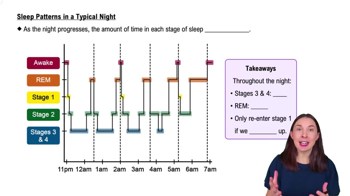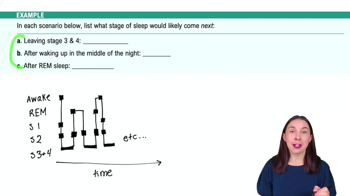Table of contents
- 1. Introduction to Psychology1h 43m
- 2. Psychology Research2h 20m
- 3. Biological Psychology2h 41m
- 4. Sensation and Perception28m
- 5. Consciousness and Sleep32m
- 6. Learning41m
- 7. Memory34m
- 8. Cognition37m
- 9. Emotion and Motivation35m
- 10. Developmental Psychology33m
- 11. Personality48m
- 12. Social Psychology41m
- 13. Stress and Health41m
- 14. Psychological Disorders44m
- 15. Treatment47m
5. Consciousness and Sleep
Sleep
Struggling with Psychology?
Join thousands of students who trust us to help them ace their exams!Watch the first videoMultiple Choice
In the classic Schachter-Singer angry person/happy person experiment, participants were given a drug to elicit a physical response and then exposed to two different conditions. One group was paired with a confederate pretending to be angry. The other group was paired with a confederate pretending to be happy. What was the main objective of this experiment?
A
To determine whether physical arousal has to be interpreted cognitively before it can be labeled as an emotion
B
To document the facial feedback hypothesis
C
To determine which response to a stimulus comes first: the physical or cognitive interpretation
D
To determine whether people with facial paralysis can experience emotions
 Verified step by step guidance
Verified step by step guidance1
Understand the context of the Schachter-Singer experiment, which is a study in the field of emotion and psychology.
Recognize that the experiment involves administering a drug to participants to induce a physical response, which is a key component of the study.
Identify the two different conditions in the experiment: one group is exposed to an angry confederate, and the other to a happy confederate.
Consider the main objective of the experiment, which is to explore the relationship between physical arousal and cognitive interpretation in the labeling of emotions.
Conclude that the experiment aims to determine whether physical arousal needs to be cognitively interpreted before it can be labeled as a specific emotion, aligning with the Schachter-Singer theory of emotion.

 3:25m
3:25mWatch next
Master Circadian Rhythms with a bite sized video explanation from Hannah Gordils
Start learningRelated Videos
Related Practice


































































































![Race, Genes and IQ Differences | Bret Weinstein [Mini Clip]](https://img.youtube.com/vi/IztL_m3pd70/mqdefault.jpg)



































































































